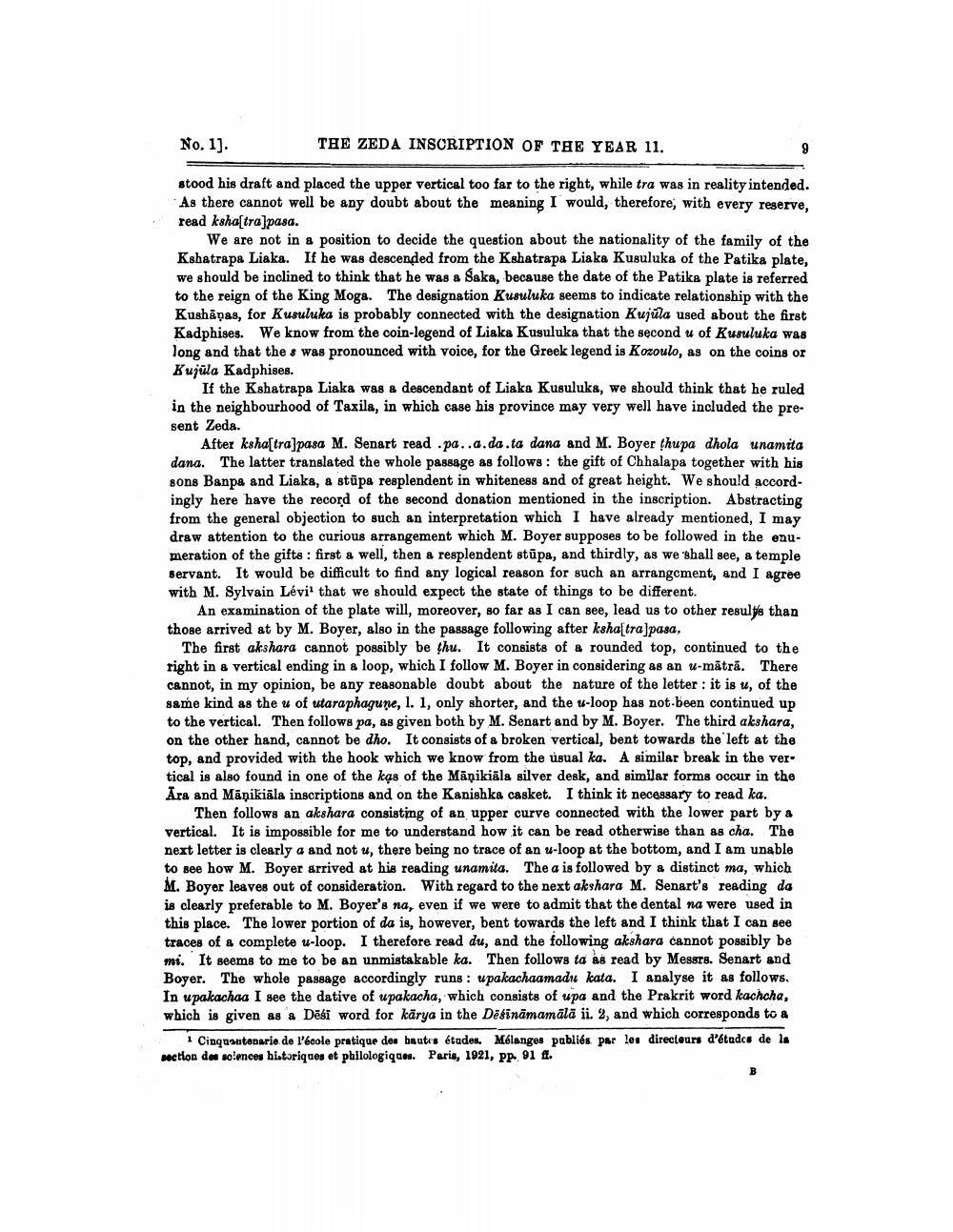________________
No. 1].
THE ZEDA INSCRIPTION OF THE YEAR 11.
stood his draft and placed the upper vertical too far to the right, while tra was in reality intended. As there cannot well be any doubt about the meaning I would, therefore, with every reserve, read ksha[tra]pasa.
We are not in a position to decide the question about the nationality of the family of the Kshatrapa Liaka. If he was descended from the Kshatrapa Liaka Kusuluka of the Patika plate, we should be inclined to think that he was a Saka, because the date of the Patika plate is referred to the reign of the King Moga. The designation Kusuluka seems to indicate relationship with the Kushāpas, for Kusuluka is probably connected with the designation Kujula used about the first Kadphises. We know from the coin-legend of Liaka Kusuluka that the second u of Kusuluka was long and that the s was pronounced with voice, for the Greek legend is Kozoulo, as on the coins or Kujula Kadphises.
If the Kshatrapa Liaka was a descendant of Liaka Kusuluka, we should think that he ruled in the neighbourhood of Taxila, in which case his province may very well have included the present Zeda.
After ksha[tra]pasa M. Senart read .pa..a.da.ta dana and M. Boyer thupa dhola unamita dana. The latter translated the whole passage as follows: the gift of Chhalapa together with his sons Banpa and Liaka, a stupa resplendent in whiteness and of great height. We should accordingly here have the record of the second donation mentioned in the inscription. Abstracting from the general objection to such an interpretation which I have already mentioned, I may draw attention to the curious arrangement which M. Boyer supposes to be followed in the enumeration of the gifts: first a well, then a resplendent stupa, and thirdly, as we shall see, a temple servant. It would be difficult to find any logical reason for such an arrangement, and I agree with M. Sylvain Lévi1 that we should expect the state of things to be different.
An examination of the plate will, moreover, so far as I can see, lead us to other result's than those arrived at by M. Boyer, also in the passage following after ksha[tra]pasa,
The first akshara cannot possibly be thu. It consists of a rounded top, continued to the right in a vertical ending in a loop, which I follow M. Boyer in considering as an u-matra. There cannot, in my opinion, be any reasonable doubt about the nature of the letter: it is u, of the same kind as the u of utaraphagune, 1. 1, only shorter, and the u-loop has not been continued up to the vertical. Then follows pa, as given both by M. Senart and by M. Boyer. The third akshara, on the other hand, cannot be dho. It consists of a broken vertical, bent towards the left at the top, and provided with the hook which we know from the usual ka. A similar break in the ver. tical is also found in one of the kas of the Māņikiāla silver desk, and similar forms occur in the Ara and Manikiāla inscriptions and on the Kanishka casket. I think it necessary to read ka.
Then follows an akshara consisting of an upper curve connected with the lower part by a vertical. It is impossible for me to understand how it can be read otherwise than as cha. The next letter is clearly a and not u, there being no trace of an u-loop at the bottom, and I am unable to see how M. Boyer arrived at his reading unamita. The a is followed by a distinct ma, which M. Boyer leaves out of consideration. With regard to the next akshara M. Senart's reading do is clearly preferable to M. Boyer's na, even if we were to admit that the dental na were used in this place. The lower portion of da is, however, bent towards the left and I think that I can see traces of a complete u-loop. I therefore read du, and the following akshara cannot possibly be mi. It seems to me to be an unmistakable ka. Then follows ta as read by Messrs. Senart and Boyer. The whole passage accordingly runs: upakachaamadu kata. I analyse it as follows. In upakachaa I see the dative of upakacha, which consists of upa and the Prakrit word kachcha, which is given as a Desi word for karya in the Dēsināmamālā ii. 2, and which corresponds to a
1 Cinquantenarie de l'école pratique des bautes études. Mélanges publiés par les directeurs d'études de la section des sciences historiques et philologiques. Paris, 1921, pp. 91 ff.




